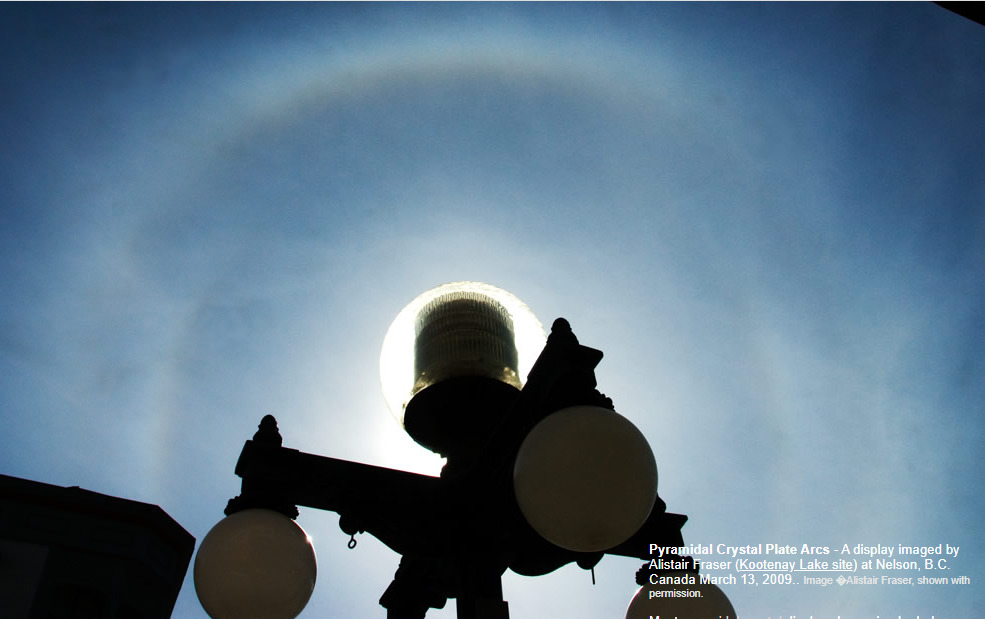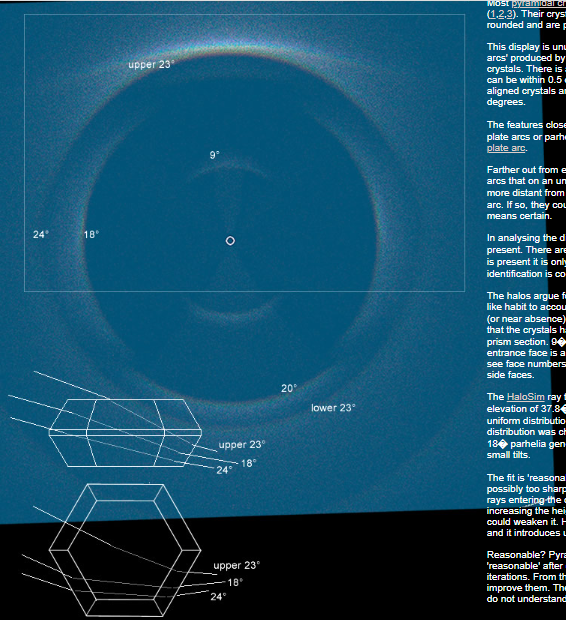Pyramidal Plate Arcs
Pyramidal Plate Arcs: Unusual Atmospheric Optics Phenomenon
Atmospheric optics never ceases to amaze us with its breathtaking displays. One such remarkable phenomenon is the pyramidal plate arcs. While most pyramidal crystal displays exhibit circular halos, the pyramidal plate arcs stand out due to their unique features produced by aligned pyramidal crystals resembling plate crystals.
The alignment of pyramidal plate crystals is a rarity, as ordinary plate crystals can deviate up to 0.5 degrees from the horizontal, whereas pyramidal plate aligned crystals are fortunate if they align within a range of 10-20 degrees. This alignment gives rise to distinct features in the pyramidal plate arcs display.
The Features of Pyramidal Plate Arcs
-
18° Plate Arcs or Parhelia: The closest features to the sun on each side of the display are 18° plate arcs or parhelia. These arcs appear as bright spots that mirror the position of the sun.
-
23° Upper Plate Arc: Positioned above the sun, the 23° upper plate arc adds to the enchantment of the display. This arc is formed by rays entering the crystal top face, creating a distinct and captivating effect.
-
Additional Arcs: Situated farther out from each side of the sun, there are two more arcs that appear slightly more distant from the sun than the 23° upper plate arc. Although it is uncertain, these arcs could potentially be 24° plate arcs.
It is worth noting that certain features are absent in this particular display, which contributes to its uniqueness:
-
No Inner 9° Arcs: The absence of inner 9° arcs or their extremely faint presence suggests that the crystals forming the pyramidal plate arcs only possess a thin central hexagonal prism section.
-
No 22° Halo: Similarly, the absence of a 22° halo indicates that the crystals involved in this display lack the necessary side faces required for its formation.
Understanding the Crystal Structure
To comprehend the formation of pyramidal plate arcs, it is essential to examine the crystal structure and its alignment. The presence of halos suggests that the crystals possess some degree of plate-like habit, accounting for their alignment. However, the alignment is not as precise as that of ordinary plate crystals.
The HaloSim ray tracing simulation provides valuable insights into the alignment and behavior of these crystals. In this simulation, a solar elevation of 37.8° was considered, and the crystals exhibited a uniform distribution of tilts ranging from ±25°. This choice was deliberate to avoid the formation of sharp V-shaped 18° parhelia, which occurs when crystals have minimal tilts.
Analyzing the Simulation Results
The simulation results provide a reasonable representation of the observed pyramidal plate arcs. However, it is important to acknowledge that these simulations often reach a state of "reasonableness" after a few iterations of crystal population and tilt adjustments. After reaching this point, significant improvements become challenging to achieve.
There may be underlying factors at play that elude our current understanding. The complexity of atmospheric optics and crystal behavior leaves room for further exploration and discovery. The study of pyramidal plate arcs continues to captivate researchers and enthusiasts alike, pushing the boundaries of our knowledge in this fascinating field.
In conclusion, pyramidal plate arcs present a captivating and unusual atmospheric optics phenomenon. Their distinct features, resulting from aligned pyramidal crystals resembling plate crystals, add a touch of mystique to the natural world around us. Through simulations and analysis, we gain valuable insights into the formation and behavior of these enchanting displays. Yet, there is still much to uncover and understand about the intricacies of pyramidal plate arcs, reminding us of the perpetual wonder that lies within our atmosphere.

Pyramidal Crystal Plate Arcs - A display imaged by Alistair Fraser (Kootenay Lake site) at Nelson, B.C. Canada March 13, 2009.. Image �Alistair Fraser, shown with permission.

Most pyramidal crystal displays have circular halos (1,2,3). Their crystals are aerodynamically rather rounded and are poorly aligned.
This display is unusual. Its dominant features are 'plate arcs' produced by pyramidal crystals aligned like plate crystals. There is a difference - ordinary plate crystals can be within 0.5 degrees of horizontal, pyramidal plate aligned crystals are lucky if aligned within 10-20 degrees.
The features closest to the sun on each side are 18� plate arcs or parhelia. Above the sun is a 23� upper plate arc.
Farther out from each side of the sun are two more arcs that on an unsharp masked image appear slightly more distant from the sun than the 23� upper plate arc. If so, they could be 24� plate arcs but this is by no means certain.
In analysing the display it is worth noting what is not present. There are no inner 9� arcs or if an upper one is present it is only a trace. If the 23� plate arc identification is correct then there is no 22� halo.
The halos argue for crystals with some degree of plate like habit to account for their alignment. The absence (or near absence) of 9� arcs or a 22� halo indicate that the crystals had only a thin central hexagonal prism section. 9� arcs have ray paths where the entrance face is a central prism side face .path 3-26, see face numbers. and the 22 degree halo requires two side faces.
The HaloSim ray tracing simulation is for a solar elevation of 37.8�. The crystals - as shown - had a uniform distribution of tilts of ±25�. The uniform distribution was chosen to avoid the sharp V-shaped 18� parhelia generated when the crystals have only small tilts.
The fit is 'reasonable'. The upper 23� plate arc is possibly too sharp and intense. The arc results from rays entering the crystal top face and in principle increasing the height of the upper pyramidal section could weaken it. However, this is only partially effective and it introduces unwanted side effects.
Reasonable? Pyramidal crystal simulations often get 'reasonable' after only a few crystal population and tilt iterations. From then on it is hard to significantly improve them. There could be factors at work that we do not understand.
Note: this article has been automatically converted from the old site and may not appear as intended. You can find the original article here.
Reference Atmospheric Optics
If you use any of the definitions, information, or data presented on Atmospheric Optics, please copy the link or reference below to properly credit us as the reference source. Thank you!
-
<a href="https://atoptics.co.uk/blog/pyramidal-plate-arcs/">Pyramidal Plate Arcs</a>
-
"Pyramidal Plate Arcs". Atmospheric Optics. Accessed on April 24, 2024. https://atoptics.co.uk/blog/pyramidal-plate-arcs/.
-
"Pyramidal Plate Arcs". Atmospheric Optics, https://atoptics.co.uk/blog/pyramidal-plate-arcs/. Accessed 24 April, 2024
-
Pyramidal Plate Arcs. Atmospheric Optics. Retrieved from https://atoptics.co.uk/blog/pyramidal-plate-arcs/.